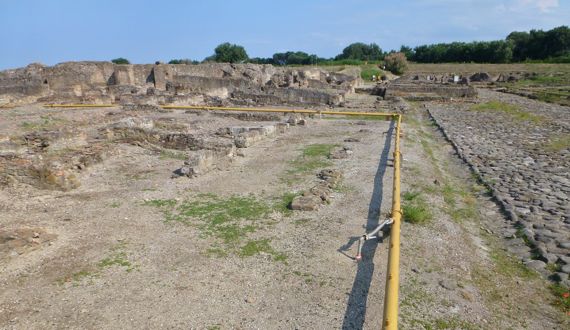
“There’s an archaeological site,” Someone Else said, “let’s stop.!”
And thus we had a wonderful guided tour of Sybaris—to the Greeks, or Copia—to the Romans. We saw the ruins of Copia, except for a stretch of the Greek’s road. (Read the Greek community’s history here.
You’re looking SSE toward the Roman center-of-town, which had a large circular city fountain, the theater, and at least one temple.
Apparently the coast side of Copia had a harbor and city gate, but the sea is now several hundred meters away. I guess sediment from the mountains washed down over the ruins protecting wall bases and floors, as well as the roads.
I’m not sure of the hydrology, but we saw and heard two busy pumps, keeping the water at bay. One place we could see the current water level, nearly 2m below the road—so the pumps must run continuously to keep the site from flooding—at least during rainy periods—and we experienced that recently. The yellow pipe is part of the water-removal system.
Thus, we have left Sicily, and are doing a quick perusal of the Ionian coast (Jonian is the spelling here). The B&B we stayed at hooked us up with a local Calabrian restaurant, and we dined with two French couples staying at the same B&B—a linguistic olympics for all of us, as we switched among French, English, and Italian, especially to discuss the foods we were eating. John used Google translate several times; for example, you gotta really know a language to know “white mulberry*” (Morus alba) in it—they were raw, fresh, sweet, and part of the fruit course along with dark, sweet cherries. Yum.
The white mulberries are probably a legacy of the silk industry. A town up the way, Catanzaro, was known historically for its velvet, silk and other textiles; I’m guessing that’s the link to the Morus alba trees….
* mûre